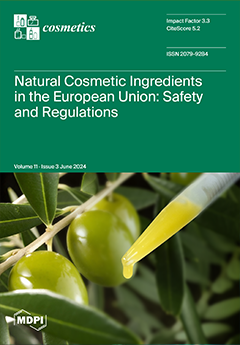Kaempferia galanga Linn. (KG), a member of the family Zingiberaceae, is native to India, and commonly found in China, Indonesia, and Thailand. It has been used as a food condiment, folk medicine, and to relieve skin diseases due to its biological activities. However,
[...] Read more.
Kaempferia galanga Linn. (KG), a member of the family Zingiberaceae, is native to India, and commonly found in China, Indonesia, and Thailand. It has been used as a food condiment, folk medicine, and to relieve skin diseases due to its biological activities. However, its anti-aging effect has not yet been investigated. In this study, the rhizome of
Kaempferia galanga Linn was extracted with solvents of different polarities (deionized water, absolute ethanol, ethyl acetate, and hexane). Phytochemical screening assay, total flavonoid and total phenolic contents, antioxidant activity (DPPH
•, FRAP, ABTS
+• assay), anti-aging activity (anti-collagenase, anti-elastase), and cell cytotoxicity on human dermal fibroblasts were investigated. The outcomes revealed that the extraction in highly polar solvents resulted in a high extract yield. Flavonoids, phenolic, and terpenoid compounds were detected in KG extracts using all extraction solvents. However, deionized water as a solvent exhibited the lowest level of flavonoids and phenolics, as compared to the other solvents. The highest total flavonoid and phenolic contents were achieved through extraction with absolute ethanol and ethyl acetate, respectively. Interestingly, the extract obtained with absolute ethanol exhibited the most potent antioxidant activities (the IC
50 value of DPPH
• was 0.612 mg/mL, the FRAP value was 62.79 mmol of Fe
2+/g of extract, and TEAC value was 9.21 mg TE/g of extract in ABTS
+• assay) and anti-aging properties (the percentages of collagenase inhibitory and elastase were 71.83%, and 66.35%, respectively). Regarding cell cytotoxicity, both KG extracts obtained with deionized water and absolute ethanol showed lower toxicity on human dermal fibroblasts compared to those obtained with ethyl acetate and hexane. Ethanol-based KG extract demonstrated a good antioxidant, anti-aging capacity and is considered safe for cosmeceutical products focused on anti-aging applications.
Full article





